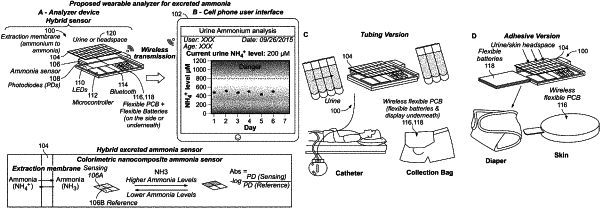| CPC A61B 5/14552 (2013.01) [A61B 5/14546 (2013.01); A61B 5/201 (2013.01); A61B 5/4866 (2013.01); B01D 53/228 (2013.01); B01D 2259/10 (2013.01)] | 20 Claims |

|
1. A system comprising an analyzer device configured to be in fluid communication with a sample of a bodily fluid, the analyzer device comprising:
a gas sensing chamber;
an extraction membrane located between: (i) an area in fluid communication with the bodily fluid and (ii) the gas sensing chamber, wherein the extraction membrane is configured to: (a) extract and convert chemically or electrochemically at least a portion of ammonium (NH4+) contained within the bodily fluid into ammonia (NH3), (b) eliminate interferences, and (c) dispel the converted ammonia (NH3) into the gas sensing chamber; and
an ammonia (NH3) sensor located within the gas sensing chamber, the ammonia sensor comprising a processor with a non-transitory memory storing instructions that, when executed, causes the processor to quantify an amount of ammonia (NH3) present in the gas sensing chamber in relation to a total ammonia of the bodily fluid, wherein the total ammonia is a sum of the ammonia (NH3) and ammonium (NH4+),
wherein the analyzer device detects, based on the quantified amount of ammonia present in the gas sensing chamber, at least one of: altered organ function, altered tissue function, and altered metabolic status.
|